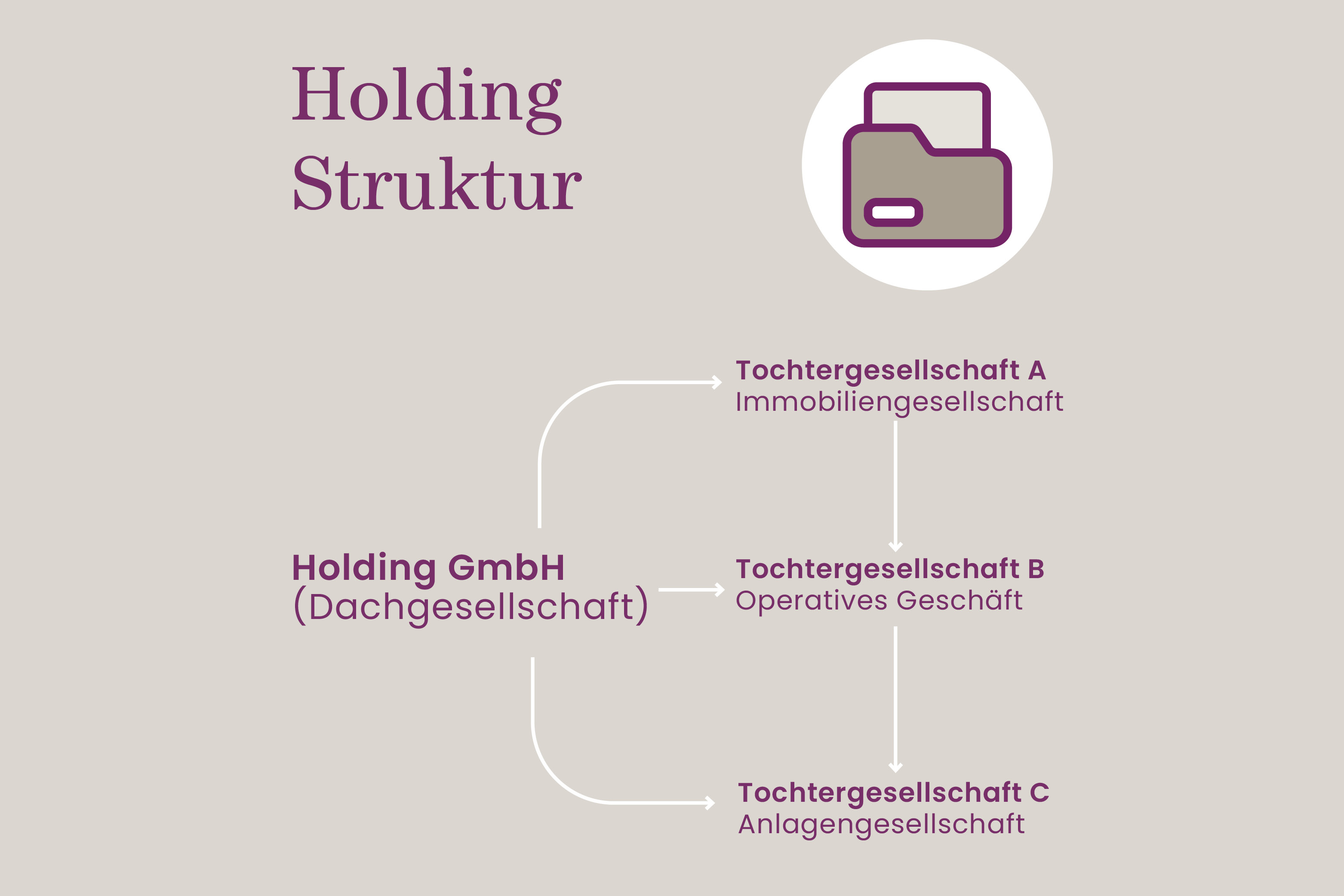How to optimise your company structure, secure your assets and minimise your tax burden

Holding GmbH: Your strategic advantage
Establishing a holding company is a strategic step that can offer your company long-term advantages. This legal form not only enables a clear separation of business and private assets, but also efficient management of company investments. But what exactly is behind the concept of a holding GmbH and how can it benefit your company?
In this guide, you will learn how a holding GmbH can strengthen your company in various areas:
- Optimising your company structure: create clear responsibilities and design business processes more efficiently.
- Protect your assets: The separation of business and private assets reduces your personal liability risk.
- Reducing your tax burden: Take advantage of tax benefits to optimise your financial performance.
- Promote your company’s growth: A holding structure offers ideal conditions for expansion and diversification.
We explain the legal and tax framework, highlight the advantages and disadvantages of a holding company and guide you step by step through the formation process.
Important note: The information provided here is of a general nature and does not replace individual legal or tax advice. Our experts are available to provide you with personalised advice.
Arrange a free initial consultation with our experts at LW.P Lüders Warneboldt now and explore your individual options together!

What is a Holding GmbH?
A holding company is a legal form that is primarily used to manage and control investments in other companies. This structure makes it possible to bundle several subsidiaries under a common holding company. The term holding company describes the central organisational unit that makes strategic decisions for the entire group of companies.
Definition and basics
The Holding GmbH is characterised by a clear separation between the holding company and the subsidiaries. While the holding company is responsible for strategic management and administration, the subsidiaries manage the operational business independently. This structure offers an efficient organisation of business activities and reduces liability risks.
Types of holding companies and examples
This holding company takes on both strategic and operational tasks. One example is a parent company that offers its own products or services in addition to managing its subsidiaries.
This structure focuses exclusively on the management of investments, such as property. A practical example is a family holding company, which is used to manage family assets and to organise succession.
This is a holding company that takes on centralised management tasks such as human resources or IT for the entire group. A typical example is a holding company in a large group of companies that centralises strategic decisions.
This type of holding company is responsible for financing and managing financial resources. An example would be a holding company that raises and manages capital for various projects within the group of companies.
The holding structure
A typical holding structure consists of a holding company (also known as the parent company) and several subsidiaries. The parent company usually holds the majority of shares in the subsidiaries and controls their strategic direction. The subsidiaries act as independent legal entities, but are strategically bound to the guidelines of the parent company. This structure enables a clear separation of responsibilities and efficient organisation of the entire group of companies.

The role of the holding company
The holding company is responsible for the centralised management and administration of the group of companies. This includes the strategic direction, monitoring of business activities and financing of the subsidiaries. Its tasks include setting objectives, developing strategies, controlling the subsidiaries and providing resources.
The tasks of the subsidiaries
The subsidiaries are responsible for operational activities. They are active in specific business areas and operate largely independently, but within the framework of the parent company’s strategic guidelines. They benefit from the support of the parent company in areas such as financing, management and centralised services.
Holding GmbH Advantages
The establishment of a capitalist holding structure has numerous advantages, including tax, legal and strategic aspects. This structure is particularly attractive for companies that want to optimise their growth strategy, guarantee asset protection or ensure an orderly company succession.

Tax advantages of a holding company
A holding company can offer considerable tax savings. § Section 8b KStG enables capitalistically structured holding companies to receive profit distributions from subsidiaries largely tax-free under certain conditions. In addition, corporate tax advantages can be used, as the tax burden within the group can be optimised, e.g. through tax groups.
Example: If a holding company receives profit distributions from a subsidiary corporation, 95% of these may be received tax-free from a corporation tax perspective. This leads to considerable tax savings compared to a structure without a holding company.
Risk minimisation and asset protection for companies
A holding structure offers effective separation of assets and liability risks. By dividing the company’s activities into several legally independent subsidiaries, the risk is isolated. This means that financial difficulties in one subsidiary do not necessarily affect the entire holding company or other subsidiaries. Valuable assets such as real estate or brand rights can be outsourced to separate companies to protect them from operational risks.
Example: A company can outsource its real estate to an asset-managing subsidiary, while the operating activities take place in another company. This protects the real estate in the event of liability claims arising from the operating business.
Flexibility and efficiency in corporate management
A holding company enables flexible and efficient corporate management. Centralised management by the holding company ensures a uniform strategic orientation and facilitates decision-making. Resources can be distributed more efficiently and synergies between the subsidiaries can be utilised. Central services such as accounting, HR management or IT can be provided by the holding company, which optimises administration.
Example: A management holding company coordinates strategic decisions centrally and provides administrative services for the subsidiaries. This allows the subsidiaries to concentrate on their core business, while the holding company takes on higher-level management tasks.
If you would like to find out more about the advantages of a Holding GmbH or check whether this structure is suitable for your company, please contact us for a non-binding consultation.

The process of founding a Holding GmbH
Setting up a holding company is a multi-stage process that requires careful planning and compliance with legal requirements. This process includes determining the appropriate organisational form, drawing up the necessary documents, selecting the location and formally registering the company.

The formation process begins with detailed planning. It is important to clearly define the structure and objectives of the holding company, for example whether the holding company will only manage investments or also be operationally active itself. Thorough preparation facilitates the foundation and helps to recognise potential challenges at an early stage.
Checklist of required documents and information:
- Identity cards or passports of all shareholders
- Articles of association (regulates the rights and obligations of the shareholders, distribution of profits, management, etc.)
- List of planned investments and their valuation (especially for contributions in kind)
- Financing plan (equity capital, borrowed capital)
- Declarations of the managing directors on the assumption of office
Choice of the right legal form and structure:
The GmbH is often the preferred legal form for holding companies due to its limited liability and flexibility. In some cases, however, a public limited company (AG) may also be considered. It is advisable to make these decisions with a tax advisor or lawyer to find the best solution for your company’s specific requirements.
The legal formation of a Holding GmbH comprises the following steps:
Notarisation: The articles of association must be notarised by a notary. The shareholders are informed of their rights and obligations and the contract is signed.
Payment of the share capital: At least half of the share capital (12,500 euros) must be paid into a bank account of the holding GmbH.
Registration with the commercial register: After notarisation and payment of the share capital, the holding GmbH must be registered with the relevant commercial register (usually the local court). The company only acquires its legal capacity once it has been entered in the commercial register.
Further formalities: After entry in the commercial register, further formalities must be completed, such as applying for a tax number from the tax office and registering with the employers’ liability insurance association.
The formation of a Holding GmbH is associated with various costs, which can vary depending on individual circumstances.
Typical costs:
- Notary fees
- court costs
- Consultancy costs
- Capital increase costs
- Ongoing costs for bookkeeping, annual financial statements, tax returns
A minimum share capital of EUR 25,000 is required to establish a GmbH. However, the amount of capital should be adapted to the specific requirements of the holding company, especially if extensive shareholdings are to be managed. In addition to the formation of a new company, a holding GmbH can also be created through the acquisition of shares in existing companies.
Financing options:
- Equity capital: Contributions from shareholders or new investors.
- Debt capital: Bank loans, bonds or other forms of credit. It is important that the holding company generates sufficient income to fulfil its interest and repayment obligations.
It is crucial to plan the capital requirements precisely and ensure that sufficient funds are available for ongoing operations and planned investments.
You can find more information on founding a GmbH in our article.

Tax and legal aspects
The formation and operation of a holding company requires a comprehensive understanding of the associated tax and legal framework. In particular, this includes the specific taxes resulting from the chosen structure as well as compliance with statutory regulations under the German Commercial Code (HGB) and the German Limited Liability Companies Act (GmbHG).
Tax obligations and regulations
Holding companies can be fully exempt from trade tax under certain conditions, provided they can utilise the so-called extended reduction, Section 9 No. 1 GewStG.
The income of a holding company is subject to corporation tax at the current rate of 15%. In addition, a solidarity surcharge of 5.5 % is levied.
Dividends distributed by a holding company to its shareholders at a private level are subject to capital gains tax of 25% plus solidarity surcharge. Distributions from subsidiaries to their parent company are subject to taxation at a rate of 5% as so-called non-deductible operating expenses. The latter can be avoided if a tax group relationship is established between the holding company and its subsidiary(ies).
Holding companies are generally subject to VAT, particularly if they provide services to their subsidiaries or third parties. There is also the possibility of tax optimisation in the area of VAT by establishing a tax group relationship, but this follows different rules than the consolidated tax group for income tax purposes.
Strategic considerations for founding a holding company
The decision to establish a holding company should be based on a sound, long-term corporate strategy. A holding structure offers numerous strategic advantages that are particularly relevant for companies that want to drive their growth, expansion and internationalisation.
Growth and expansion
A holding company creates ideal conditions for company growth and expansion into new markets. By structuring the company into subsidiaries, companies can clearly separate different business areas and manage them more efficiently. This structure enables a targeted allocation of resources for growth projects and risk diversification.
Example: A medium-sized company in the renewable energy sector is planning to enter the electromobility market. By founding a subsidiary that focuses exclusively on the development and sale of charging stations, the company can tap into this new business area without jeopardising its core business. The risk is diversified, as any setbacks in the new business area do not directly jeopardise the entire company.
Internationalisation
The Holding GmbH offers considerable advantages for internationally orientated companies. By establishing subsidiaries in different countries, not only can tax advantages be utilised and liability limited, but market risks can also be diversified. This structure makes it possible to spread business activities across different countries, which facilitates market entry and makes it easier to adapt to local legal and tax conditions.
Centralised management and control of international activities is also facilitated, which supports the strategic orientation of the entire company and accelerates decision-making processes.
Asset protection and succession planning
A holding structure is ideal for long-term asset management and asset protection. By outsourcing valuable assets to separate subsidiaries, they can be protected from operational risks. This is particularly important for real estate, patents or other important company resources.
Holding GmbH also offers a flexible platform for company succession. The transfer of shares in the Holding GmbH is easier to handle than the transfer of shares in individual operating companies. This facilitates succession planning and ensures the continuity of business operations.
Example: A family business plans the company succession to ensure that the company remains in family ownership. By establishing a family holding company, the company shares can be bundled centrally and gradually transferred to the next generation. This enables an orderly succession and minimises the risk of inheritance disputes.
Holding GmbH Disadvantages and potential challenges
In addition to the numerous advantages, the establishment of a holding company also harbours potential challenges. These should be carefully weighed up in advance and included in the strategic planning.

Complexity of the structure
Managing a holding structure can be complex due to the number of subsidiaries and their different fields of activity. This complexity requires a high degree of organisation and overview in order to achieve both strategic and operational goals. Increased complexity can slow down decision-making, especially when many stakeholders are involved and extensive coordination processes are necessary.
Costs and administrative effort
The administrative costs of a holding company are generally higher than for simpler corporate structures. Each subsidiary requires separate accounting and the preparation of its own annual financial statements. In addition, tax obligations must be fulfilled for each unit. The costs of setting up and running the holding company can be significant, including notary and court fees, ongoing accounting and legal fees and compliance costs.
In addition, the administration of the holding company may require an increased need for qualified personnel in order to ensure the efficient management of the various companies.
Our services for the formation and administration of a holding GmbH
LW.P Lüders Warneboldt offers customised solutions that support companies in the establishment and management of holding structures. Our broad expertise covers tax advice, legal advice, corporate structuring, financing and the integration of notarial services from notaries with whom we regularly work.
This comprehensive expertise enables us to provide you with competent support at all stages of the process.
Our tax consultancy specialises in making the most of the tax advantages of a holding structure. We develop individual tax strategies to minimise your tax burden. In doing so, we always ensure compliance with the current legal framework and also advise you on international tax issues, supported by our network within the HLB Group.
Our experienced lawyers support you in the legal organisation of your holding structure. This includes the drafting and review of articles of association, the legal protection of corporate structures and adherence to compliance regulations. We accompany you through the entire formation process and represent your interests even in complex legal issues.
In the area of corporate structuring, we develop efficient and flexible structures for your holding company and its subsidiaries. Our management consultants work closely with you to optimise processes and minimise risks. We also support you in international expansion and adaptation to local legal and economic conditions.
Our experts provide you with comprehensive advice on all questions relating to the financing of your holding company. We create financing concepts and support you in raising capital, whether through equity or debt capital. Our aim is to create a solid financial basis that meets your strategic objectives and to guide you through financing rounds and expansion projects.
The notaries working with us offer comprehensive support in notarising all relevant documents in connection with the establishment of a holding company. This includes drawing up articles of association, making entries in the commercial register and providing legal support for other notarial procedures. We ensure that all formalities are handled correctly and efficiently.
Conclusion: Advantages and considerations for founding a holding GmbH - Your expert advice from LW.P Lüders Warneboldt
The formation of a holding company offers many strategic advantages, such as tax savings, asset protection and more efficient company management. This guide has comprehensively explained the relevant tax and legal framework as well as strategic considerations.
A holding structure is particularly suitable for companies that want to optimise their growth strategy, implement clear succession planning or tap into international markets. However, it is important to consider the additional administrative requirements and associated costs.
We recommend that you obtain detailed information about the requirements and advantages of a holding company and seek professional advice.
Contact us to find out more about how a holding structure can strengthen your company and what specific advantages it offers. Our team looks forward to providing you with in-depth expertise.

FAQ - Frequently asked questions about founding a holding company
A holding company, also known as a holding company, is a company whose main purpose is to hold and manage shares in other companies (subsidiaries). The holding company itself is generally not operationally active, but concentrates on the strategic management and control of its subsidiaries. A special form is the management holding company, which coordinates central tasks such as the strategic planning and management of the group of companies and often also provides centralised services for the subsidiaries.
Companies set up a holding company to benefit from tax advantages, protect their assets and create an efficient corporate structure. This structure enables a clear separation of operational business units and asset management. Start-ups can thus develop and finance different business models separately, while established companies can plan their expansion and succession.
A minimum share capital of 25,000 euros is required to establish a holding GmbH. However, depending on the scope of the planned activities and the specific legal form, further costs may be incurred, such as notary and court fees as well as consultancy costs.
In principle, any natural or legal person can set up a holding company. There are no special restrictions as long as the legal requirements for the chosen legal form are met.
A holding structure can already be worthwhile for companies with just one subsidiary if, for example, tax advantages are to be used or liability risks minimised. As a rule, however, the establishment of a holding company only becomes interesting when there are two or more subsidiaries.
A holding company functions through the centralised control and management of its subsidiaries. The parent company (holding company) holds shares in these companies and controls their strategic direction. The subsidiaries carry out the operational activities and are legally independent, but are subject to the control of the holding company.
The annual costs for a Holding GmbH depend on various factors, including the complexity of the structure, the number of subsidiaries and the specific requirements of the company. Typical costs include:
- Accounting and tax advisory costs,
- Costs for the preparation of the annual financial statements,
- If applicable, expenses for legal advice and compliance,
- and costs for the administration of investments.

